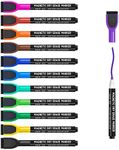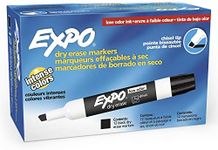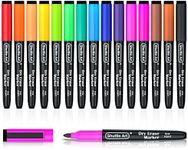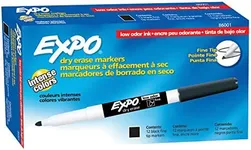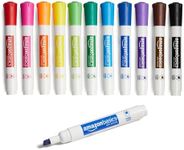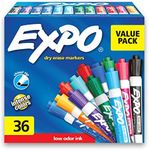Buying Guide for the Best Dry Erase Markers
Choosing the right dry-erase markers can make a big difference in your writing or drawing experience, whether you're using them for teaching, office work, or creative projects. It's important to consider how you'll use the markers, the surfaces you'll write on, and your preferences for color and tip style. By understanding the key features, you can select markers that are easy to use, last longer, and give you the results you want.Ink TypeInk type refers to the formula used in the marker, which affects how easily it erases, how vibrant the color appears, and whether it has a strong odor. Most dry-erase markers use alcohol-based ink, which dries quickly and erases cleanly, but some are low-odor or even odorless, making them better for small or poorly ventilated spaces. If you are sensitive to smells or will be using the markers in a classroom or meeting room, low-odor ink is a good choice. For outdoor or industrial use, standard ink may be more durable.
Tip StyleTip style describes the shape and size of the marker's writing point, such as fine, chisel, or bullet. Fine tips are best for detailed writing or small boards, chisel tips can create both thick and thin lines depending on the angle, and bullet tips offer consistent medium lines. If you need to write clearly on a large board, a chisel or bullet tip is ideal, while fine tips are better for detailed work or writing in small spaces.
Color VarietyColor variety refers to the range of colors available in a set of markers. Some sets offer just black, blue, red, and green, while others include a wide spectrum of colors. If you need to organize information, highlight different topics, or make your writing more engaging, a larger color selection can be helpful. For basic note-taking or simple presentations, a few standard colors may be enough.
ErasabilityErasability is how easily the marker can be wiped off the board without leaving stains or ghosting. Some markers erase cleanly with a dry cloth or eraser, while others may leave behind residue. If you plan to reuse your board frequently or need to keep it looking clean, look for markers known for easy erasing. For temporary notes that don't need to be perfect, erasability may be less important.
LongevityLongevity refers to how long the marker lasts before drying out or running out of ink. Markers with larger ink reservoirs or special ink formulas tend to last longer. If you use markers often or for long sessions, choose ones known for durability. For occasional use, longevity may not be as critical.
Surface CompatibilitySurface compatibility means how well the marker works on different types of dry-erase boards, such as glass, melamine, or porcelain. Some markers are designed specifically for glass boards and may not perform as well on traditional whiteboards. If you know the type of board you'll be using, check that the markers are recommended for that surface to ensure the best results.

